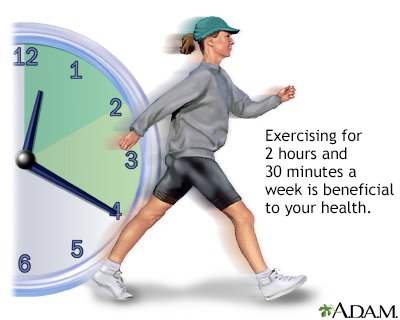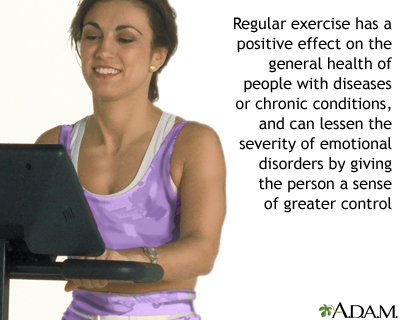Exercise and activity for weight loss
Weight loss - activity; Weight loss - exercise; Obesity - activity

You get the most benefit from exercise if you do it for at least 30 minutes a day for 5 to 6 days a week. But you do not have to do 30 minutes in a row. Recent studies suggest that you get the same benefits if you work out for 10 minutes 3 times a day that you do during a longer session.

Physical activity contributes to health by reducing the heart rate, decreasing the risk for cardiovascular disease, and reducing the amount of bone loss that is associated with age and osteoporosis. Physical activity also helps the body use calories more efficiently, thereby helping in weight loss and maintenance. It can also increase basal metabolic rate, reduces appetite, and helps in the reduction of body fat.

Weight lifting is a form of anaerobic exercise. It is very demanding, requiring a great deal of energy, which quickly depletes the body’s oxygen reserves. Sprinting and push-ups are other examples of anaerobic activities. They each create a situation called oxygen debt, which requires us to breathe deeply and rapidly in order to restore a proper oxygen level to the muscle cells. Let’s take a look at this woman exercising her right biceps muscle. Repetitions of this exercise cause her biceps muscle fibers to increase in size. As she works out, if no more oxygen is available, her muscles convert a starch, called glycogen, into energy. This conversion process creates a waste product called lactic acid, which can be partly responsible for her muscle soreness the next day. Conversely, jogging is a form of aerobic exercise. Exercising over a long duration requires a steady level of energy for the body. If properly conditioned, the body will be able to supply adequate oxygen to meet its energy requirements during aerobic exercise and much less lactic acid will be formed in the muscles.
The Weight-loss Formula
Calories used in exercise and daily living > calories eaten = weight loss.
This means that to lose weight, the number of calories you burn by daily living and exercising needs to be greater than the number of calories from the foods you eat and drink. Even if you work out a lot, if you eat more calories than you burn, you will gain weight.
Another way to look at this is that a woman aged 30 to 50 years old who does not exercise needs about 1,800 calories a day to maintain her normal weight. A man aged 30 to 50 years old who does not exercise needs about 2,200 calories to maintain his normal weight.
For every hour of exercise they do, they would burn:
- 240 to 300 calories doing light activity such as cleaning house or playing baseball or golf.
- 370 to 460 calories doing activity such as a brisk walk (3.5 mph), gardening, biking (5.5 mph), or dancing.
- 580 to 730 calories doing activity such as jogging at a pace of 9 minutes per mile, playing football, or swimming laps.
- 740 to 920 calories doing activity such as running at a pace of 7 minutes per mile, playing racquetball, and skiing.
Even if you don't change the amount of calories in your diet, but you do add activity to your daily life, you'll lose weight or gain less weight.
Benefits of Weight Loss
An exercise weight-loss program that works needs to be fun and keep you motivated. It helps to have a specific goal. Your goal might be managing a health condition, reducing stress, improving your stamina, or being able to buy clothes in a smaller size. Your exercise program may also be a way for you to be with other people. Exercise classes or exercising with a buddy are both good social outlets.
You may have a hard time starting an exercise routine, but once you do, you will begin to notice other benefits. Improved sleep and self-esteem might be a couple of them. Other benefits you may not notice include increased bone and muscle strength and a lower risk for heart disease and type 2 diabetes.
Getting Started
You do not need to join a gym to get exercise. If you have not exercised or been active in a long time, be sure to start off slowly to prevent injuries. Taking a slow 10-minute walk twice a week is a good start. Then make it more brisk over time. Add time and frequency if you can.
You can also try joining a dance, yoga, or karate class. You could also join a baseball or bowling team, or even a mall-walking group. The social aspects of these groups can be rewarding and motivating.
The most important thing is that you do exercises that you enjoy and are practical so that it is easier to sustain what you are doing.
Build Physical Activity into Your Regular Routine
Simple lifestyle changes can make a big difference over time.
- At work, try taking the stairs instead of the elevator, walking down the hall to talk with a co-worker instead of sending an e-mail, or adding a 10- to 20-minute walk during lunch.
- When you are running errands, try parking at the far end of the parking lot or down the street. Even better, try walking to the store.
- At home, try taking on common chores such as vacuuming, washing a car, gardening, raking leaves, or shoveling snow.
- If you ride the bus, get off the bus one or more stops before your usual stop and walk the rest of the way.
Reduce Your Screen Time
Sedentary behaviors are things you do while you are sitting still. Decreasing your sedentary behaviors can help you lose weight. For most people, the best way to decrease sedentary behavior is to reduce the time they spend watching TV and using a computer and other electronic devices. All of these activities are called "screen time."
Some ways to decrease the harm of too much screen time are:
- Choose 1 or 2 TV programs to watch and turn off the TV when they are over.
- Don't keep the TV on all the time for background noise -- you might end up sitting down and watching it. Turn on the radio instead. You can be up doing things around the house and still listen to the radio.
- Don't eat while you are watching TV.
- Before you turn on the TV, take your dog for a walk. If you are going to miss your favorite show, record it.
- Find activities to replace TV watching. Read a book, play a board game with family or friends, or take an evening class.
- Work out on an exercise mat while you watch TV. You will burn calories.
- Ride a stationary bike or use a treadmill while you watch TV.
If you like playing video games, try games that require you to move your whole body, not just your thumbs.
How Much Exercise do you Need?
Aim to exercise about 2.5 hours a week or more. Do moderate-intensity aerobic and muscle-strengthening activities. Depending on your schedule, you could exercise 30 minutes 5 days a week or 45 to 60 minutes 3 days a week.
You do not have to do your total daily exercise all at once. If your goal is to exercise for 30 minutes, you can break that up into shorter time periods that add up to 30 minutes.
As you become more fit, you can challenge yourself by increasing the intensity of your exercise by going from light activity to moderate activity. You can also increase the amount of time you exercise.
References
Apovian CM, Istfan NW. Obesity: guidelines, best practices, new research. Endocrinol Metab Clin North Am. 2016;45(3):xvii-xviii. PMID: 27519142
Barb D, Donahoo WT, Considine RV. Obesity: risk, risk factors, and medical management. In: Robertson RP, ed. DeGroot's Endocrinology. 8th ed. Philadelphia, PA: Elsevier; 2023:chap 20.
Jensen MD, Bessesen DH. Obesity. In: Goldman L, Cooney KA, eds. Goldman-Cecil Medicine. 27th ed. Philadelphia, PA: Elsevier; 2024:chap 201.
US Preventive Services Task Force; Curry SJ, Krist AH, et al. Behavioral weight loss interventions to prevent obesity-related morbidity and mortality in adults: US Preventive Services Task Force Recommendation Statement. JAMA. 2018;320(11):1163-1171. PMID: 30326502
Version Info
Last reviewed on: 7/15/2024
Reviewed by: Frank D. Brodkey, MD, FCCM, Associate Professor, Section of Pulmonary and Critical Care Medicine, University of Wisconsin School of Medicine and Public Health, Madison, WI. Also reviewed by David C. Dugdale, MD, Medical Director, Brenda Conaway, Editorial Director, and the A.D.A.M. Editorial team.
